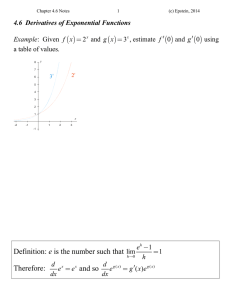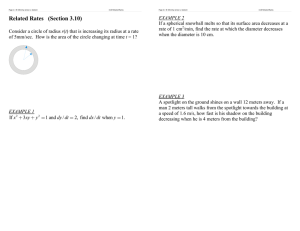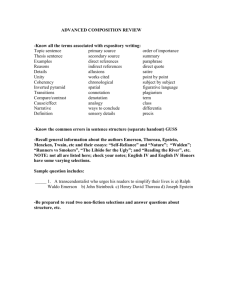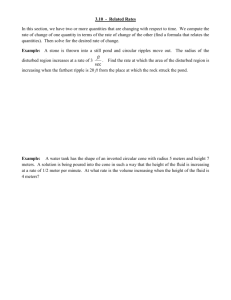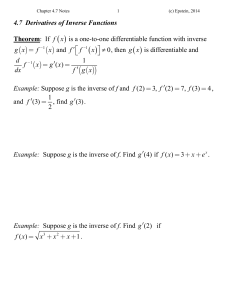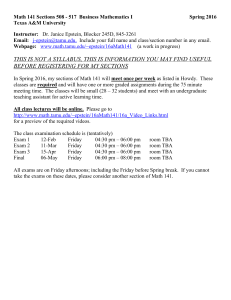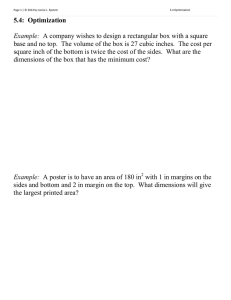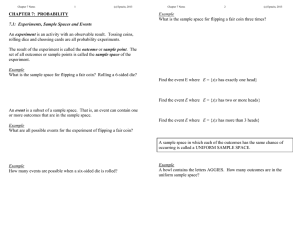( ) ( ) 4.4 Chain Rule and Higher Derivatives
advertisement
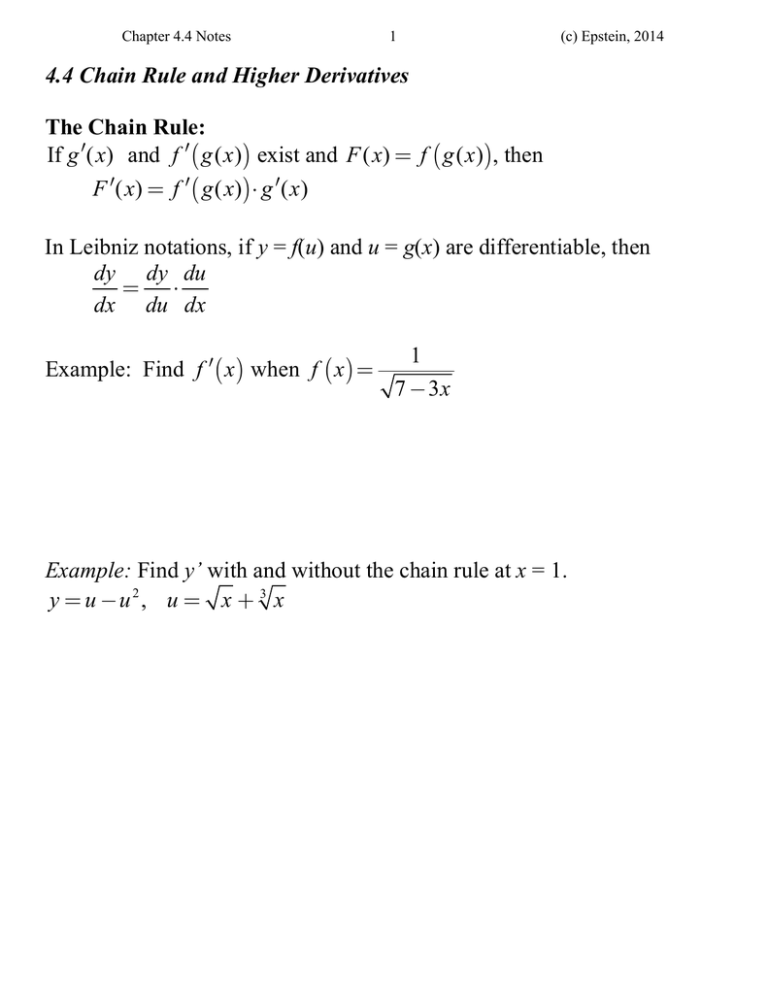
Chapter 4.4 Notes 1 (c) Epstein, 2014 4.4 Chain Rule and Higher Derivatives The Chain Rule: If g ¢( x) and f ¢ ( g ( x)) exist and F ( x) = f ( g ( x)), then F ¢ ( x ) = f ¢ ( g ( x ))⋅ g ¢ ( x ) In Leibniz notations, if y = f(u) and u = g(x) are differentiable, then dy dy du = ⋅ dx du dx Example: Find f ¢ ( x) when f ( x) = 1 7 - 3x Example: Find y’ with and without the chain rule at x = 1. y = u -u2, u = x + 3 x Chapter 4.4 Notes 2 (c) Epstein, 2014 Commonly use the chain rule and the power rule together, d n n-1 du u = nu ( ) dx dx Example: Find the derivatives of the following functions F ( x) = ( x3 - 5 x) 4 g (t ) = (6t + 5) (t - 7) 2 3 4 3 2 æ ö÷ çç x ÷÷ y =ç ÷÷ 2 çç 2 2 x 1 1 ) ÷ø è ( Chapter 4.4 Notes 3 (c) Epstein, 2014 Example: Find the equation of the tangent line to the curve at the given point. y = x + (1/ x ), (1, 2 ) Example: Suppose that w = u◦v and u(0) = 1, v(0) = 2, u′ (0) = 3, u’(2) = 4, v′ (0)=5, and v′ (2) = 6. Find w′ (0). Chapter 4.4 Notes 4 (c) Epstein, 2014 4.4.2 Implicit Differentiation dy when x + y = 4 Example: Find dx When y = f(x), then y is an explicit function of x and y′= dy/dx is straightforward. When this is not the case, we can use implicit differentiation which consists of differentiating both sides of the relation with respect to x and solving for y′. x+ y =4 Example: Find dy when dx xy - 2 x = y y 5 + 3 x 2 y 2 + 5 x 4 = 12 Chapter 4.4 Notes 5 (c) Epstein, 2014 Example: Regard y as the independent variable and x as the dependent variable and find dx/dy for ( x 2 + y 2 ) = ax 2 y 2 2 Example: If [ g ( x)] + 12 x = x 2 g ( x) and g (3) = 4, find g ¢(3). Example: Find an equation of the tangent line to the curve at the given point. x 2 / 3 + y 2 / 3 = 4 at -3 3,1 ( ) 8 6 4 2 0 -8 -6 -4 -2 0 -2 -4 -6 -8 2 4 6 8 Chapter 4.4 Notes 6 (c) Epstein, 2014 4.4.3 Related Rates Example: Consider a circle of radius r(t) that is increasing its radius at a rate of 5mm/sec. How is the area of the circle changing at time t = 1? Example: If x 2 + 3 xy + y 2 = 1 and dy / dt = 2, find dx / dt when y = 1. Chapter 4.4 Notes 7 (c) Epstein, 2014 Example: If a spherical snowball melts so that its surface area decreases at a rate of 1 cm2/min, find the rate at which the diameter decreases when the diameter is 10 cm. Example: A spotlight on the ground shines on a wall 12 meters away. If a man 2 meters tall walks from the spotlight towards the building at a speed of 1.6 m/s, how fast is his shadow on the building decreasing when he is 4 meters from the building? Chapter 4.4 Notes 8 (c) Epstein, 2014 Example: At noon, ship A is 150 km west of ship B. Ship A is sailing east at 35 km/hr and ship B is sailing north at 25 km/hr. How fast is the distance between the ships changing at 4:00 PM? Example: A storm is 50 miles offshore and its path is perpendicular to a straight shoreline. It is approaching the show at a rate of 4 mph. A van traveling along the shoreline wants to stay exactly 50 miles from the storm and remain along the shoreline. The van starts at the point on the shoreline in the path of the storm. Find a formula for the speed that the van must maintain to remain 50 miles from the storm. What is the speed of the van when the storm is 40 miles from shore? Chapter 4.4 Notes 9 (c) Epstein, 2014 4.4.4 Higher Derivatives The second derivative of the function y = f(x) is ö÷ d 2 y d d æç d y ¢¢ = f ¢¢( x) = ( f ¢( x)) = ç f ( x)÷÷ = 2 = D 2 f ( x) = Dx2 f ( x) ø dx dx dx çè dx The third derivative of the function y = f(x) is d d3y y ¢¢¢ = f ¢¢¢( x) = ( f ¢¢( x)) = 3 = D 3 f ( x) = Dx3 f ( x) dx dx The nth derivative of the function y = f(x) is d (n-1) dny (n) (n) ( x) = n = D n f ( x) = Dxn f ( x) y = f ( x) = f dx dx ( ) Example: Find the second derivative of the following functions 1 g (u ) = 1- u Example: Find a formula for f ( ) ( x ) when f ( x ) = n 1 (1- x) 2 Chapter 4.4 Notes 10 (c) Epstein, 2014 The instantaneous rate of change of the velocity is the acceleration. So if s(t) is the position of an object at time t, the acceleration is a (t ) = v ¢(t ) = s ¢¢(t ) Example: Given the position in meters at time t in seconds of an object is given by s = 2t3-9t2 , find the times when the acceleration is zero. At the times when the acceleration is zero, where is the object and what is the object’s velocity? Example: Find f ¢¢( x) if f ( x) = g ( x 3 ) + ( g ( x)) 3 Example: Find y ¢¢ by implicit differentation for x + y = 1. Chapter 4.4 Notes 11 (c) Epstein, 2014 Example: Find f′ and f′′. Sketch f, f′ and f′′ and determine their domains. f ( x) = x 2 - x
